
Turmeric is a flowering plant, Curcuma longa, of the ginger family, Zingiberaceae, the rhizomes of which are used in cooking. The plant is a perennial, rhizomatous, herbaceous plant native to the Indian subcontinent and Southeast Asia that requires temperatures between 20 and 30 °C and a considerable amount of annual rainfall to thrive. Plants are gathered each year for their rhizomes, some for propagation in the following season and some for consumption.

Zingiberaceae or the ginger family is a family of flowering plants made up of about 50 genera with a total of about 1600 known species of aromatic perennial herbs with creeping horizontal or tuberous rhizomes distributed throughout tropical Africa, Asia, and the Americas. Members of the family Zingiberaceae including turmeric, ginger, Javanese ginger, and galangal have been used for centuries in traditional medicine. Preclinical studies of Zingiberaceae extracts have shown analgesic properties.
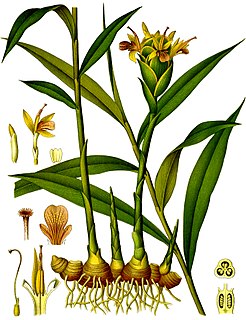
The genus Zingiber is native to Southeast Asia especially in Thailand, China, the Indian Subcontinent, and New Guinea. It contains the true gingers, plants grown the world over for their medicinal and culinary value. The most well known are Z. officinale and Z. mioga, two garden gingers.

Curcuma alismatifolia, Siam tulip or summer tulip is a tropical plant native to Laos, northern Thailand, and Cambodia. Despite its name, it is not related to the tulip, but to the various ginger species such as turmeric. It can grow as an indoor plant, and is also sold as a cut flower.

Curcuma is a genus of plants in the family Zingiberaceae that contains such species as turmeric and Siam tulip. They are native to Southeast Asia, southern China, the Indian Subcontinent, New Guinea and northern Australia. Some species are reportedly naturalized in other warm parts of the world such as tropical Africa, Central America, Florida, and various islands of the Pacific, Indian and Atlantic Oceans. Generally, most curcuma grows well in loose and sandy soil in shaded areas.
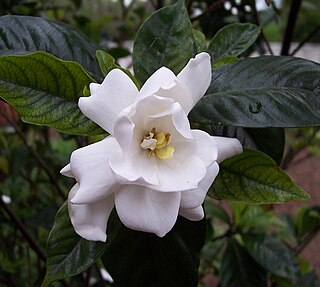
Gardenia is a genus of flowering plants in the coffee family, Rubiaceae, native to the tropical and subtropical regions of Africa, Asia, Madagascar and Pacific Islands, and Australia.

Kaempferia galanga, commonly known as kencur, aromatic ginger, sand ginger, cutcherry, is a monocotyledonous plant in the ginger family, and one of four plants called galangal. It is found primarily in open areas in Indonesia, southern China, Taiwan, Cambodia, and India, but is also widely cultivated throughout Southeast Asia.
Heliciopsis is a genus of about thirteen species of trees, constituting part of the flowering plant family Proteaceae. They grow naturally in Burma, Indo-China, SE. China, Thailand, Peninsular Malaysia, Borneo, Sumatra, Java (Indonesia) and the Philippines. The name means similar to the plant genus Helicia. Its closest relatives are Athertonia (Australia) and Virotia.
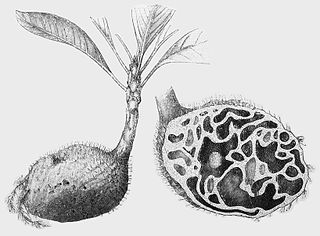
Hydnophytum is a genus of epiphytic myrmecophytes native to Southeast Asia, the Pacific region and also extending into Queensland in northern Australia. The name is derived from the Ancient Greek hydnon "tuber", and phyton "plant", after their appearance with their swollen succulent stems. The species grow in tree branches and on trunks. Like the related genus Myrmecodia, they are known as antplants or ant-house plants. The type species is Hydnophytum formicarum from the Philippines. The genus contains 55 species, of which 44 are found in and around the island of New Guinea. Many are poorly known, with 11 known only from the holotype.
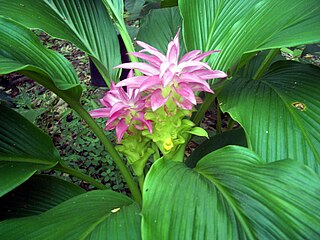
Curcuma australasica, the native turmeric or Cape York lily, is a rhizomatous herbaceous perennial plant of the Zingiberaceae or ginger family.
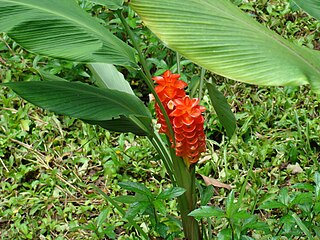
Curcuma roscoeana is a plant of the Zingiberaceae or ginger family.

Curcuma petiolata is a plant of the Zingiberaceae or ginger family.
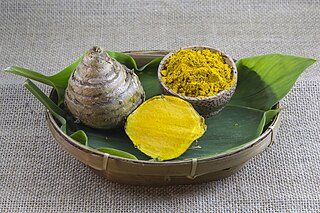
Curcuma zanthorrhiza, known as temulawak, Java ginger, Javanese ginger, or Javanese turmeric is a plant species, belonging to the ginger family. It is known in Javanese as temulawak, in Sundanese as koneng gede and in Madurese as temu labak. The scientific name is sometimes written as Curcuma xanthorrhiza, but this is an orthographical variant.
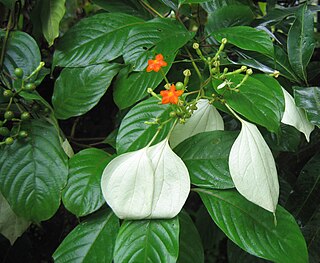
Mussaenda is a genus of flowering plants in the family Rubiaceae. They are native to the African and Asian tropics and subtropics. Several species are cultivated as ornamental plants.

Hornstedtia is a genus of plants in the Zingiberaceae. It is native to Southeast Asia, the Himalayas, southern China, New Guinea, Melanesia and Queensland.

Karel Heyne (1877–1947) was a Dutch botanist, known for his comprehensive handbook on the useful plants of the Dutch East Indies ; this was the first such handbook and became a standard reference.
Etlingera subulicalyx is a monocotyledonous plant species first described by Theodoric Valeton, and given its current name by Rosemary Margaret Smith. Etlingera subulicalyx is part of the genus Etlingera and the family Zingiberaceae.
Etlingera heyniana is a monocotyledonous plant species first described by Theodoric Valeton and given its current name by Rosemary Margaret Smith. Etlingera heyniana is part of the genus Etlingera and the family Zingiberaceae.
Curcuma rhomba is a monocotyledonous plant species described by John Donald Mood and Kai Larsen. Curcuma rhomba is part of the genus Curcuma and the family Zingiberaceae.
Curcuma bicolor is a species of flowering plant in the ginger family. It was first described by John Donald Mood and Kai Larsen.














